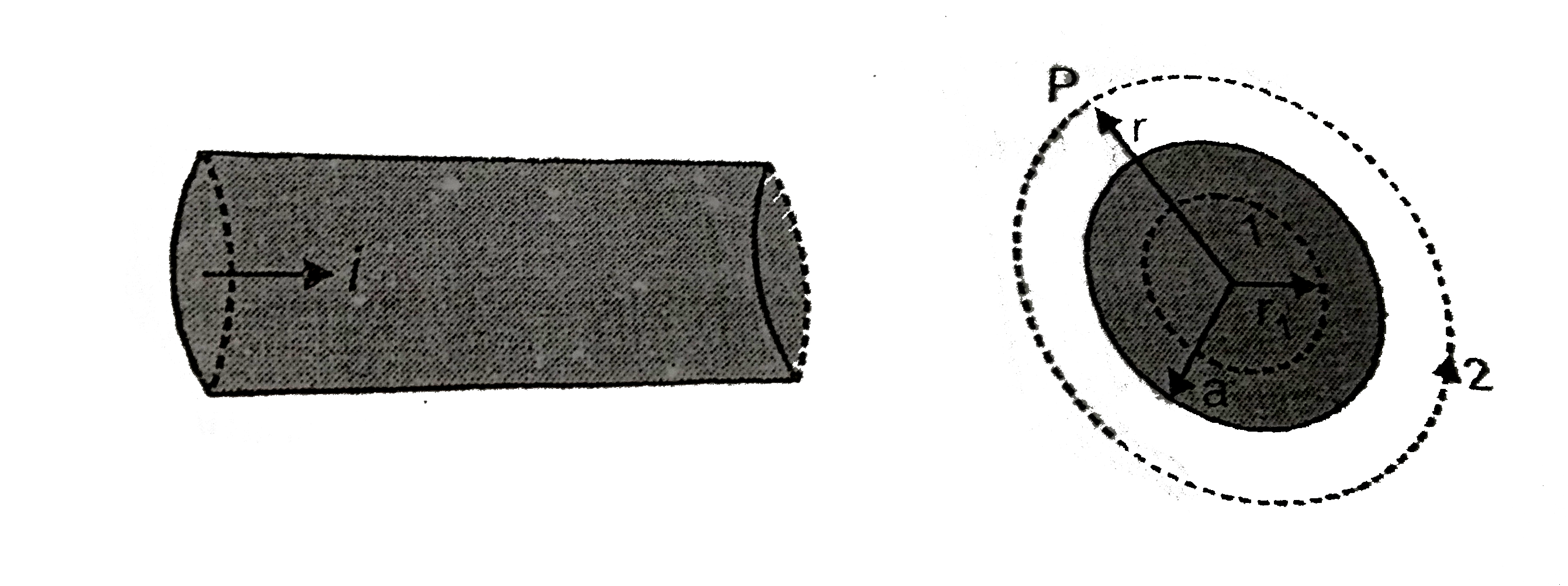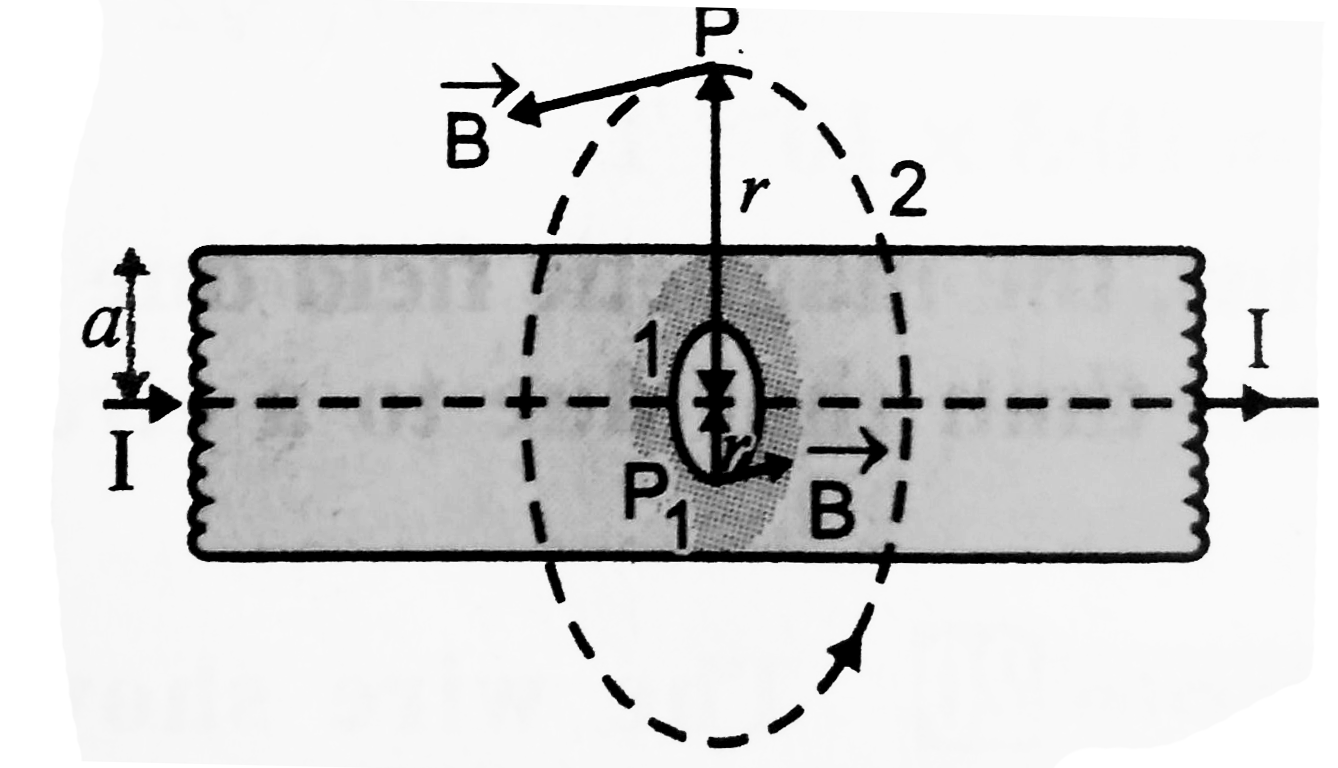A long straight wire of a circular cross-section of radius 'a' carries a steady current I. The current is uniformly distributed across the cross-section. Apply Ampere's circuital law to calculate the magnetic field at a point at distance 'r' in the region for (i) r<a and (ii) r>a.
To solve the problem of finding the magnetic field at a distance 'r' from a long straight wire carrying a steady current 'I', we will apply Ampere's circuital law in two cases: when r<a (inside the wire) and when r>a (outside the wire).
Step 1: Understanding Ampere's Circuital Law
- Ampere's circuital law states that:
∮B⋅dl=μ0Ienc
where μ0 is the permeability of free space, B is the magnetic field, and Ienc is the current enclosed by the loop.
Step 2: Case 1 - When r<a (Inside the Wire)
- For a point inside the wire, we consider a circular Amperian loop of radius r.
- The current is uniformly distributed across the cross-section of the wire.
- The enclosed current Ienc can be calculated as:
Ienc=I⋅Area of the Amperian loopTotal area of the wire=I⋅πr2πa2=Ir2a2
Step 3: Applying Ampere's Law for r<a
- Substitute Ienc into Ampere's law:
B⋅(2πr)=μ0(Ir2a2)
- Rearranging gives:
B=μ0Ir2πa2
Step 4: Case 2 - When r>a (Outside the Wire)
- For a point outside the wire, we again consider a circular Amperian loop of radius r.
- In this case, the entire current I is enclosed:
Ienc=I
Step 5: Applying Ampere's Law for r>a
- Substitute Ienc into Ampere's law:
B⋅(2πr)=μ0I
- Rearranging gives:
B=μ0I2πr
Final Results:
- For r<a:
B=μ0Ir2πa2
- For r>a:
B=μ0I2πr
- Ampere's circuital law states that:
∮B⋅dl=μ0Ienc
where μ0 is the permeability of free space, B is the magnetic field, and Ienc is the current enclosed by the loop.
- For a point inside the wire, we consider a circular Amperian loop of radius r.
- The current is uniformly distributed across the cross-section of the wire.
- The enclosed current Ienc can be calculated as:
Ienc=I⋅Area of the Amperian loopTotal area of the wire=I⋅πr2πa2=Ir2a2
- Substitute Ienc into Ampere's law:
B⋅(2πr)=μ0(Ir2a2)
- Rearranging gives:
B=μ0Ir2πa2
- For a point outside the wire, we again consider a circular Amperian loop of radius r.
- In this case, the entire current I is enclosed:
Ienc=I
- Substitute Ienc into Ampere's law:
B⋅(2πr)=μ0I
- Rearranging gives:
B=μ0I2πr
- For r<a:
B=μ0Ir2πa2
- For r>a:
B=μ0I2πr
Topper's Solved these Questions
- XII BOARDSBOOK - XII BOARD PREVIOUS YEAR PAPER ENGLISHCHAPTER - XII BOARDSEXERCISE - C.B.S.E.CLASS-XII PHYSICS (THEORY) [SET-I] (SECTION-A)
5 Videos
- XII BOARDSBOOK - XII BOARD PREVIOUS YEAR PAPER ENGLISHCHAPTER - XII BOARDSEXERCISE - SECTIONS-B
4 Videos
- XII BOARDSBOOK - XII BOARD PREVIOUS YEAR PAPER ENGLISHCHAPTER - XII BOARDSEXERCISE - SECTION-C
50 Videos
- SAMPLE PAPER 2019BOOK - XII BOARD PREVIOUS YEAR PAPER ENGLISHCHAPTER - SAMPLE PAPER 2019EXERCISE - SECTION D
6 Videos
Similar Questions
A long straight wire of a curcular cross-section of radius 'a' carries a steady current 'l'. The current is uniformly distributed the across- section . Apply Amphere's circuital law to calculate the magnetic field at a point 'r' in the region for (i) r<a and (ii) r>a.
View SolutionFigure shows a long straight wire of a circular cross-section (radius a) carrying steady current l. The current l is uniformly distributed across this cross-section. Calculate the magnetic field in the region r<aandr>a

View SolutionFigure shows a long straight wire of circular crosssection (radius a) carrying steady current I. The current I is uniformly distributed across this crosssection. Calculate the magnetic field in the region r<a and r>a.

View SolutionA long straight wire of radius a carries a steady current i. The current is uniformly distributed across its cross section. The ratio of the magnetis field at (a)/(2)and(2a) is
View SolutionA long straight wire of a circular cross section (radius a) carrying steady current. Current is uniformly distributed in the wire. Calculate magnetic field inside the region (r<a) in the wire.
View SolutionA long thick conducting cylinder of radius 'R' carries a current uniformly distributed over its cross section :
View SolutionA long staright wire of radius a carries a steady current I. The curent is unifromly distributed over its cross-section. The ratio of the magnetic fields B and B' , at radial distances a2 and 2a respectively from the axis of the wire is:
View SolutionA long straight conducting solid cylindrical wire of radius R carries a steady current / that is uniformly distributed throughout the cross section of the wire. Draw graph of magnetic field B versus r (where r is distance from the axis of the wire)
View SolutionA long straight wire of circular cross- section carries a current along its length. On the axis inside the wire, it follows that
View SolutionA uniform current I is flowing in a long wire of radius R. If the current is uniformly distributed across the cross-sectional area of the wire, then
View Solution
